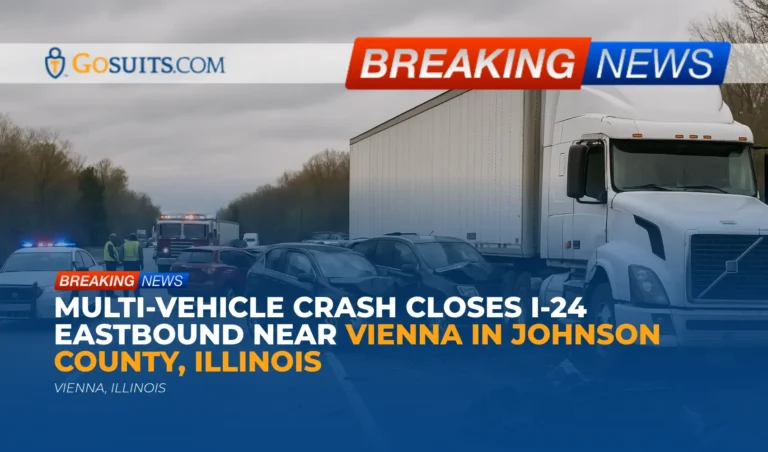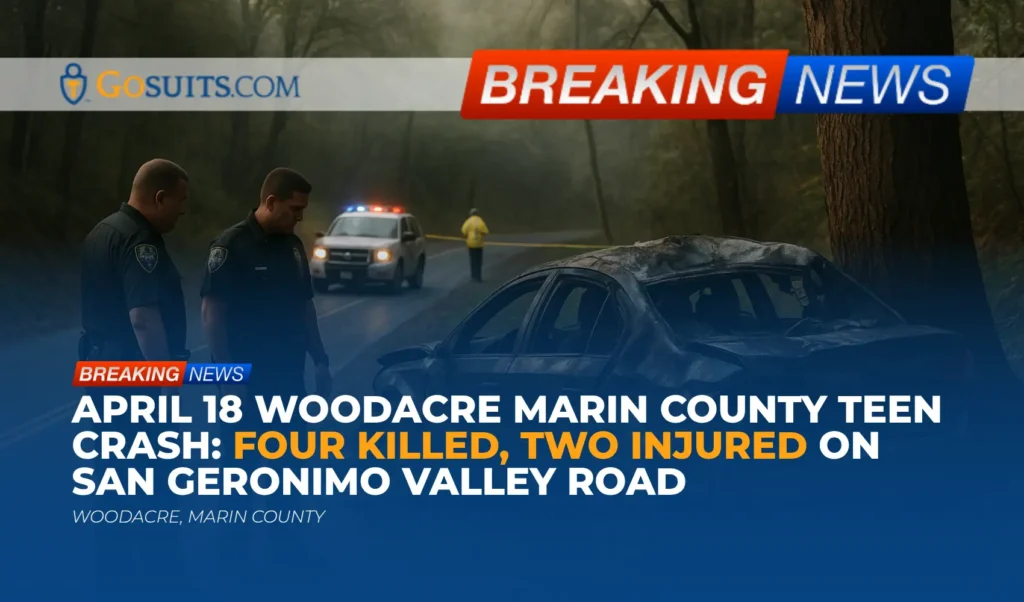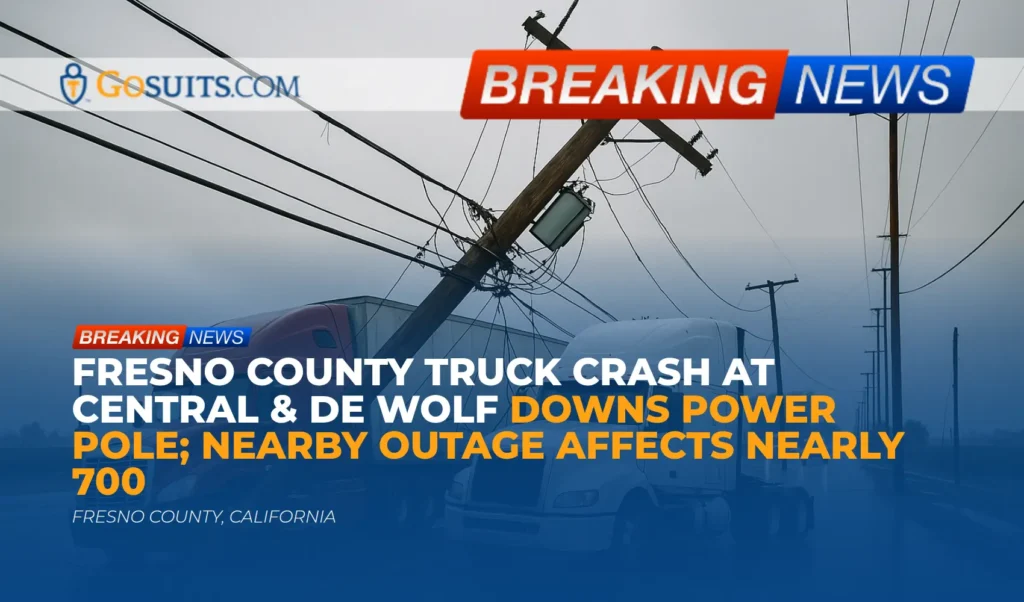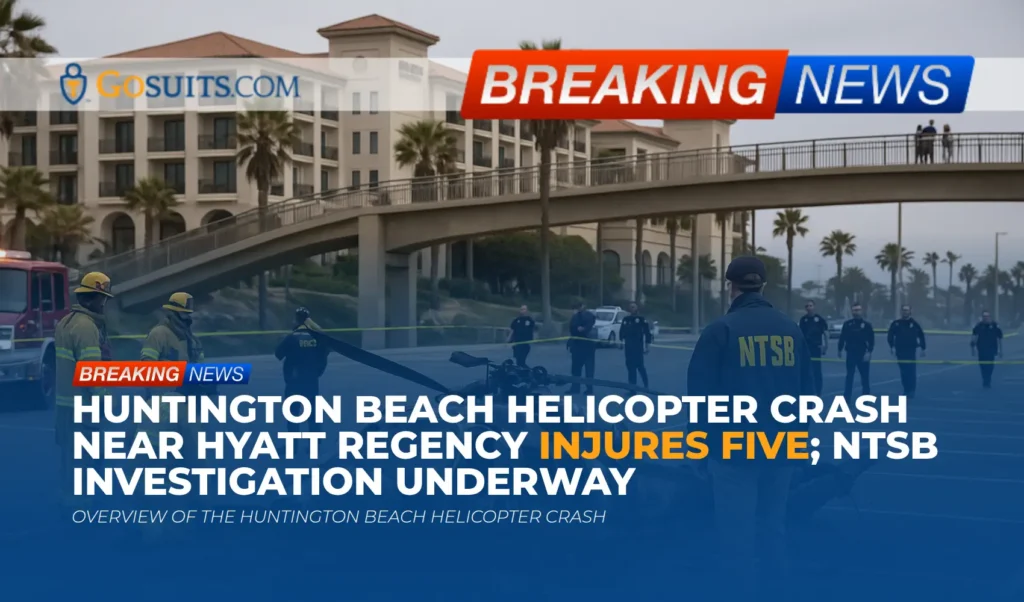- What Happened on I‑24 Eastbound in Johnson County
- Key Facts Known So Far
- Location, Road Conditions, and Detours
- How Illinois Authorities Investigate Multi‑Vehicle Crashes
- Where Families Can Request Official Records
- Preserving Evidence After a Multi‑Vehicle Crash
- Potential Liability in Chain‑Reaction and Multi‑Vehicle Collisions
- Insurance Considerations and Common Pitfalls
- Understanding Civil Rights After Serious Injury or Loss in Illinois
- Safety and Traffic Management Considerations
- Reliable Sources for Ongoing Updates
- Commentary from Gosuits Vienna, Illinois Personal Injury Attorney
- Time‑Sensitive Next Steps
- Referenced Government and Academic Sources
What Happened on I‑24 Eastbound in Johnson County
Illinois State Police responded to a multi‑vehicle crash on Interstate 24 eastbound near milepost 3 in Johnson County, close to Vienna, Illinois. Authorities indicated that the interstate was closed at that location, and motorists were advised to use alternate routes until further notice. At the time of this report, officials had not released public details about the number of vehicles involved, the cause of the crash, or potential injuries. Road closures of this type typically signal that responders are conducting scene safety measures, caring for anyone who may be hurt, and preserving evidence for the crash investigation.
Our thoughts are with everyone affected. When a highway is closed for a multi‑vehicle incident, the uncertainty is difficult for families waiting for information. The purpose of this article is to summarize what is known, explain the typical investigative process in Illinois, and outline practical steps for obtaining records and protecting legal rights after a serious crash.
Key Facts Known So Far
Based on the initial public information:
- Location: Interstate 24 eastbound at approximately milepost 3, Johnson County, Illinois, near Vienna.
- Incident Type: Multi‑vehicle crash.
- Agency on Scene: Illinois State Police.
- Traffic Status: Eastbound lanes at the location were closed, with drivers asked to detour.
- Unknowns at this time: Specific causes, the total number of involved vehicles, whether commercial vehicles were part of the crash, and the injury status of motorists. These details often become available after initial investigation and scene clearance.
When official updates are released, they commonly include preliminary findings, road reopening times, and instructions for obtaining the traffic crash report. The timeline for public updates varies depending on the complexity of the scene and whether specialized reconstruction is needed.
Location, Road Conditions, and Detours
Interstate 24 is an interstate corridor that crosses Southern Illinois. Milepost 3 is in Johnson County near Vienna, a rural region where response teams may include Illinois State Police, local fire and EMS, and tow and recovery services. During extended closures, state agencies may coordinate traffic rerouting on nearby state and county roads.
For motorists, the safest approach during such closures is to follow official detours, remain patient, and avoid re‑entering the scene. Secondary collisions are a significant risk around an original crash site, especially when traffic backs up.
How Illinois Authorities Investigate Multi‑Vehicle Crashes
Multi‑vehicle collisions often require careful documentation. Illinois State Police and participating agencies typically complete written and photographic documentation, identify witnesses, and capture measurements that help with reconstruction. If commercial carriers are involved, investigators may review driver logs, vehicle maintenance records, and onboard electronic data when applicable.
In larger crashes, specialized crash reconstruction officers may be called to determine the sequence of impacts. Investigation tasks can include:
- Scene mapping and photographs: Documenting final rest positions, skid or yaw marks, and road conditions.
- Vehicle inspections: Looking at impact points, lighting, tires, brakes, and safety restraint systems.
- Event Data Recorder review: Some vehicles store pre‑crash information such as speed, brake use, and throttle position. Preservation and access require proper handling protocols.
- Witness and driver statements: Statements are taken to understand perception and reaction times, visibility, and traffic flow.
Authorities may take days or weeks to complete a full report, particularly if injuries are involved or if reconstruction is necessary.
Where Families Can Request Official Records
After a serious crash, official documents can help families understand what happened and can be important for insurance claims. Some records are available promptly, while others take time. Consider the following avenues:
Illinois State Police District Office
Johnson County is served by Illinois State Police District 22, which is based in Ullin. District pages provide contact information for requesting crash reports, traffic updates, and guidance on next steps after a highway incident. The district page is available through the Illinois State Police website: Illinois State Police District 22.
Illinois State Police Crash Reports and Public Records
Crash reports can often be requested through the Illinois State Police public records process. Some documents are obtainable through the Freedom of Information Act process, subject to redactions required by law. For general record requests, visit: Illinois State Police FOIA.
Death Certificates and Autopsy Records
If a crash results in a fatality, families often need official death certificates for practical matters, including estate and insurance. In Illinois, death certificates are issued through the Illinois Department of Public Health. Information on requesting certified copies is here: Illinois Department of Public Health, Death Certificates.
Autopsy and coroner investigative records are maintained by the county coroner’s office. These records can be subject to statutory restrictions and timing, especially while investigations are active. Families can contact the Johnson County Coroner’s Office for process and availability. If guidance is needed on whether specific records can be released, the Illinois Freedom of Information Act governs public records access. The statute is available here: Illinois Freedom of Information Act, 5 ILCS 140.
EMS and Hospital Records
Emergency medical services reports and hospital records are generally subject to privacy laws. With proper authorization, patients or next of kin can request copies from the responding EMS provider and treating hospitals. These records often include clinical assessments, imaging, and notes that can clarify the nature and extent of injuries.

Preserving Evidence After a Multi‑Vehicle Crash
Evidence can change or disappear quickly after vehicles are removed and debris is cleared. Preserving information early, when safe and feasible, can help clarify what happened later on:
- Photographs and video: Capture vehicle positions, roadway conditions, damage points, lane markings, and visible debris patterns.
- Contact information: Collect names and phone numbers of independent witnesses who may later be difficult to locate.
- Vehicle preservation: Before authorizing repairs or salvage, consider whether the vehicle should be inspected by a qualified investigator. Modern vehicles often contain Event Data Recorder information. Information on these systems is published by the National Highway Traffic Safety Administration: NHTSA Event Data Recorder overview.
- Personal property: Preserve car seats, seat belt components, and other parts that may be relevant to understanding injuries and crash forces.
- Document injuries and care: Keep discharge summaries, imaging, medication lists, and follow‑up instructions in one place. Create a timeline of symptoms and medical appointments.
Potential Liability in Chain‑Reaction and Multi‑Vehicle Collisions
Multi‑vehicle crashes can involve complex questions about who is legally responsible. Often, multiple drivers contribute to the sequence of impacts, and responsibility can be apportioned among the parties. In Illinois, the civil system uses a modified comparative fault rule. Under Illinois law, a person’s recovery can be reduced by their percentage of fault, and recovery is barred if that person’s fault exceeds 50 percent. The statute setting out comparative fault principles is available here: 735 ILCS 5/2‑1116.
Determining liability in these crashes may involve analyzing:
- Following distance and speed: Whether drivers maintained control and appropriate spacing given traffic and visibility.
- Sudden stops or lane changes: Whether the sequence began with an abrupt maneuver or obstruction ahead.
- Weather and lighting: Conditions that affect perception and reaction time.
- Commercial vehicle factors: Hours‑of‑service compliance, loading, maintenance, and fleet safety policies, when relevant.
- Roadway conditions: Construction zones, signage, and temporary traffic control devices.
Chain‑reaction collisions sometimes involve several insurance carriers and competing narratives. Neutral evidence such as physical measurements, data downloads, and third‑party witness statements often carry significant weight when accounts conflict.
Insurance Considerations and Common Pitfalls
Insurance issues after a multi‑vehicle collision can be confusing, especially when there are overlapping claims. Some general principles may help guide next steps:
- Speak with an attorney before contacting insurers: Anything said to an insurer, including your own, can be used later and may be taken out of context. Obtaining a free consultation with a qualified attorney first can help clarify rights and obligations before recorded statements are given.
- Bodily injury and property damage coverages: Multiple carriers may be involved. Coverage limits, exclusions, and priority of coverage can affect how medical bills and repairs are handled.
- Uninsured and underinsured motorist coverage: In a multi‑vehicle chain, at‑fault drivers may lack adequate coverage. UM or UIM coverage can be important depending on the circumstances.
- Medical payments coverage: Some policies include med‑pay benefits that can help with immediate medical expenses regardless of fault, subject to the policy terms.
- Recorded statements and authorizations: Broad blanket medical authorizations or early recorded statements can affect later claims. It is prudent to review requests with counsel before signing or speaking on the record.
Understanding Civil Rights After Serious Injury or Loss in Illinois
Illinois civil law provides paths to seek compensation for harms caused by another’s negligence in traffic crashes. This may include medical costs, lost income, and the human impact of pain, disability, or loss. Families who have suffered a loss may proceed under Illinois’ Wrongful Death Act, which addresses losses suffered by the next of kin. The Wrongful Death Act can be reviewed here: 740 ILCS 180, Wrongful Death Act.
Illinois generally applies a two‑year limitation period for personal injury claims. The statute of limitations is located in the Illinois Code of Civil Procedure. For personal injury actions, see 735 ILCS 5/13‑202. Wrongful death actions generally must be brought within two years as well, as set out in the Wrongful Death Act. Certain circumstances can change deadlines, for example when public entities are involved or when minors are claimants. Given how quickly time can pass during medical recovery or grieving, it is wise to clarify deadlines early with a legal professional. This information is general and is not a substitute for individualized guidance.
Safety and Traffic Management Considerations
Understanding why these crashes happen can help communities reduce risk. Federal research emphasizes that secondary crashes can occur when traffic backs up unexpectedly. The Federal Highway Administration provides an overview of Traffic Incident Management, which focuses on fast, safe clearance to reduce secondary crashes and protect responders. See: FHWA Traffic Incident Management overview.
From a driver safety perspective, maintaining safe following distances, obeying posted speeds, using headlights in low‑visibility conditions, and avoiding distraction are essential. When approaching stopped emergency vehicles on the shoulder or in the travel lanes, Illinois requires drivers to reduce speed and change lanes when safe to do so. This is commonly referred to as Scott’s Law, found at 625 ILCS 5/11‑907.
Nationally, large multi‑vehicle crashes are relatively rare compared to two‑vehicle collisions, but when they occur they can lead to substantial injuries because multiple impacts compound forces on occupants. The National Highway Traffic Safety Administration’s crash data systems provide public information on these trends and factors. See NHTSA’s Fatality Analysis Reporting System overview: NHTSA FARS.
Reliable Sources for Ongoing Updates
For official information on highway operations and safety initiatives in Illinois, the following resources are useful:
- Illinois State Police District 22: Contact information for the district that covers Johnson County, for questions about crash reporting and public information, is available at ISP District 22.
- Illinois State Police FOIA: For public records requests connected to crash documentation, see ISP FOIA portal.
- Illinois Department of Public Health: For death certificates when needed, see IDPH Death Certificates.
- Illinois Department of Transportation: IDOT publishes safety programs and statewide traffic safety data at IDOT.
- FHWA Traffic Incident Management: National guidance on incident clearance and responder safety at FHWA TIM.
- NHTSA Crash Data Systems: National resources on crash data and safety research at NHTSA FARS.
These sources provide general guidance and data. For specific details about this crash, official releases by Illinois State Police or local authorities are the primary reference points once they are issued.
Commentary from Gosuits Vienna, Illinois Personal Injury Attorney
First and foremost, our hearts go out to everyone affected by the I‑24 crash in Johnson County. Highway incidents are frightening, and the aftermath can feel overwhelming. This discussion is for educational purposes and general information, and it does not replace personalized guidance tailored to a specific situation.
In our view, multi‑vehicle crashes often turn on small moments of timing and visibility. One driver’s sudden stop or a brief lapse in attention can cascade into a chain reaction. That is why early, careful documentation is so important. Neutral evidence such as roadway measurements, vehicle damage patterns, and any available data from onboard systems often clarifies responsibility when accounts differ.
Insurance carriers and large companies that become involved after a crash, including commercial fleets, have teams that move quickly. Adjusters and risk managers may request recorded statements or broad medical releases soon after an incident. Those requests can seem routine, yet they are designed to gather information that may later be used to limit or deny claims. Understanding what must be provided, and what can wait until the facts are clearer, helps level the playing field.
A free consultation with a seasoned injury attorney can be an important first step, even before speaking with an insurance company. The goal is to understand rights, deadlines, and the evidence that needs to be preserved, so that short‑term decisions do not create long‑term problems. Every case is different, and a thoughtful plan based on the available facts is essential.

Time‑Sensitive Next Steps
The following practical steps can help protect information and options after a serious highway crash. These are general suggestions and may not apply in every circumstance.
- Clarify the investigative agency and report number: Identify which Illinois State Police district handled the scene, and obtain the crash report number when it becomes available. Track that number for future records requests.
- Preserve the vehicles and key parts: Ask towing and storage facilities to hold vehicles until a qualified inspection can occur. This can be time sensitive if storage fees accumulate or if insurers push for a quick total loss settlement.
- Gather medical documentation: Save emergency department paperwork, imaging reports, and discharge instructions. Start a treatment timeline that includes dates, providers, and symptoms.
- Locate independent witnesses: If possible, identify drivers or bystanders not directly involved in the crash whose perspectives may be more neutral. Independent statements can make a significant difference in multi‑vehicle investigations.
- Consult an attorney before speaking with insurers: Before providing any recorded statement or signing authorizations, take advantage of a free consultation to understand the scope of what is being requested. What is said to an insurer can be used later.
- Request official records promptly: Use the Illinois State Police FOIA portal for eligible public documents and contact IDPH for necessary vital records in the event of a fatality. Some records have waiting periods, so starting early helps.
- Note civil deadlines: Illinois law sets time limits to bring claims, and certain circumstances can alter those limits. Early clarification prevents last‑minute issues.
Request the official crash report when available Preserve and inspect involved vehicles Speak with a qualified attorney before insurer statements Organize medical and employment documentation
Referenced Government and Academic Sources
The resources below offer official information about Illinois law, public records, and roadway safety. They are included to support the general guidance provided above.
- Illinois State Police, District 22
- Illinois State Police, FOIA
- Illinois Department of Public Health, Death Certificates
- Illinois Wrongful Death Act, 740 ILCS 180
- Illinois statute of limitations for personal injury, 735 ILCS 5/13‑202
- Illinois comparative fault statute, 735 ILCS 5/2‑1116
- Scott’s Law, 625 ILCS 5/11‑907
- FHWA, Traffic Incident Management
- NHTSA, Fatality Analysis Reporting System
- NHTSA, Event Data Recorder overview
- Illinois Department of Transportation






